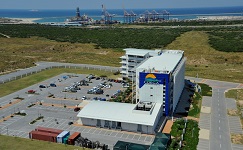Natural gas power plant to boost South Africa's energy security
12 August 2015
A liquid natural gas (LNG) power plant is being planned for Port Elizabeth that
is expected to be South Africa's most efficient and safest energy capacity
expansion.
The project, led by the Coega Development Corporation, falls under Operation
Phakisa, a governmental results-driven approach that involves clear plans and
rapidly achievable targets. It comprises on-going monitoring of progress to quickly
unlock economic growth and development.
According to the US's Energy Information Administration (EIA), natural gas
production is expected to hit 10% of the global crude production by 2020. Leading
LNG exporters include Qatar, Italy, France and Japan.
Natural gas could be considered the most environmentally friendly fossil fuel
because it has the lowest CO2 emissions per unit of energy and is suitable for use
in high efficiency combined cycle power stations. Burning the natural gas produces
about 30% less carbon dioxide than
petroleum and 45% less than burning coal.
Being safe, environmentally friendly and cost-effective means the industry is
an attractive option for South Africa and offers a much-needed boost for the
country's energy security.
Coega IDZ
The Coega Development Corporation is the operator of the Coega Industrial
Development Zone (IDZ) in Nelson Mandela Bay. Established in 1999, the IDZ is
South Africa's foremost location for new industrial investments, with the CDC
aiming to provide a competitive investment location and a total business solution
for its customers, as well as ensuring sustainable economic development in the
region.
To date, the corporation has delivered on its mandate to provide socio-
economic development for Eastern Cape, enabling the creation of almost 100 000
jobs and training for just over 70 000 people. It has 29 operational investors and an
investment portfolio of more than R151-billion.
Combined cycle gas
turbine
Earlier this week, the CDC issued a tender notice for an environmental impact
assessment for a combined cycle gas turbine (CCGT) power facility at the Coega
IDZ. It will link to the LNG terminal at the Port of Ngqura, a deep-water seaport
adjacent to the zone.
Sandisiwe Ncemane, the CDC energy sector manager, explained that the new
stage in the Port Elizabeth project would support the government's Integrated
Resource Plan and a 2012 ministerial determination allocation of 2 652MW for
energy from natural gas between 2021 and 2025.
"Up to [now], [Coega] and various state organs undertook a lot of valuable
preparatory work. The technical feasibility and financial viability of the project had
been broadly established," said Ncemane.
Five environmental impact assessment studies support gas-to-power solutions
as viable fast energy solutions, including a marine pipeline servitude report which is
under way. Also considered was a draft
scoping report by Eskom and the Central
Energy Fund that saw potential in a feasible LNG-to-power project in South Africa. A
Transnet study identified several suitable locations at Port of Ngqura for the
development.
Dedisa test
The proposed CCGT plant will be the second power plant in the Coega IDZ after
the Dedisa Peaking Power Plant, a liquid fuel open cycle gas turbine with a 342MW
generation capacity. Last month, Dedisa transferred power to the national grid
during a test exercise and the facility is scheduled to go online later this year.
"Policy developments such as the proposed Gas Utilisation Master Plan and the
establishment of the Gas Independent Power Producer Procurement Programme
inform the progress on the development of the LNG terminal and second gas power
plant in the Coega IDZ," Ncemane said.
South Africa currently has three gas production fields off the south coast. There
is no active onshore exploration, but desktop
studies are being conducted for
feasibility. The Petroleum Agency South Africa this week announced that 45
companies had active onshore and offshore permits and rights.
Ncemane noted that the development of the LNG terminal and second gas plant
for the Coega IDZ was imminent, as the berth facility at the Port of Ngqura allowed
the country to import LNG as a short-term bridging solution while the country's
nascent indigenous gas exploration and production industry developed.
Energy solution
"There is no doubt in my mind that the Coega IDZ and port is ready to be part
of the solution for improving energy security in the country through LNG. The CDC
is well positioned to develop a second gas fired plant through our expertise and
track-record with Dedisa."
The Coega IDZ also has the necessary labour at its disposal through its
construction track record with Dedisa. "We have now built a labour force with high
absorption of local human
resources, who are ready to work on this new project,"
said Duncan Grenfell, the head of recruitment and placement at the corporation.
"An LNG-to-power plant at Coega will be one of the most efficient capacity
expansion options for South African energy security. Gas-fired power plants make
efficient use of natural resources and relatively low CO2 emissions because of high
thermal efficiency," concluded Ncemane.
Source: Coega
Development Corporation
 Coega Development Corporation is the operator of the Coega Industrial Development Zone (IDZ) in Nelson Mandela Bay. Established in 1999, the IDZ is South Africa's foremost location for new industrial investments. (Image: Coega Development Corporation)
Coega Development Corporation is the operator of the Coega Industrial Development Zone (IDZ) in Nelson Mandela Bay. Established in 1999, the IDZ is South Africa's foremost location for new industrial investments. (Image: Coega Development Corporation)




